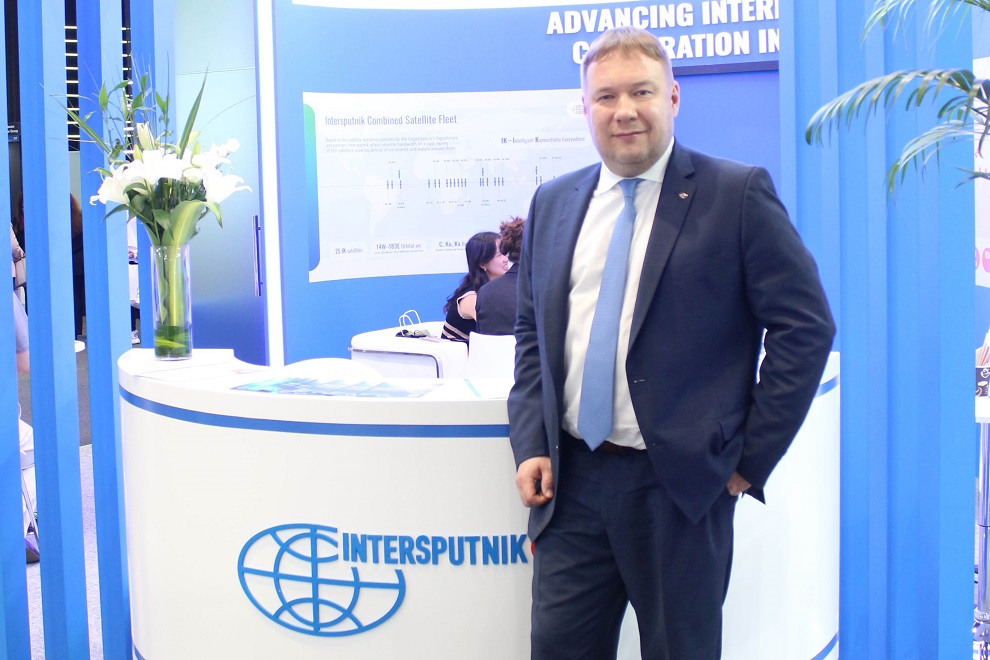Andrey Kirillovich, Director of Strategy, Marketing, and Business Development at Intersputnik, talks to Teletimes about the evolving satellite industry and the role of Intersputnik (as an intergovernmental organization) in a market where different technologies and offerings are continuously converging
Gulraiz Khalid: Could you share with us your career journey and what led you to your current role at Intersputnik?
Andrey Kirillovich: As part of the generation born at the end of the 70s, I witnessed huge developments in space exploration globally, mostly as part of the space race. This advanced space science and development far ahead, so much so that these achievements set in the 70s and 80s still have an impact and are used by many players in the industry. On the other hand, the 90s were a crazy time, boosting telecom development, starting the decade with a wired copper dial phone, and ending with a cellular phone owned by almost everyone. The early 2000s were also marked by the first attempts to connect the unconnected by satellite. With this in mind, and taking into account that I graduated from a telecom university in the year 2000, there was no other path for me but to join a satellite operator as my first official employment. With this, I have remained in the satcom industry for almost 24 years. So, I started at a GEO operator, which was managing a fleet of 10+ GEO satellites in C/Ku and Ka bands, selling transponders and international circuits, starting from narrowband links of 512/64 Kbps, and finally moving to tens and hundreds of Mbps. I had a good experience working in various positions: Contracts, Key Accounts, Sales, and then Business Development, obtaining good experience in the space segment. Then I also spent almost 5 years with a VSAT vendor, the ground segment provider, which gave me a good understanding of satellite networking and traffic routing in satellite networks. This means I have obtained experience throughout the entire value chain for satcom connectivity services. And through all these years, I have been excited by the unique opportunity that satellite communications provide globally – connecting communities, countries, and continents. Since I was engaged in various projects involving multiple locations, countries, vendors, teleports, and service providers, this was a good example of international cooperation that helped reduce the costs of connecting via satellite and provided digital inclusion and bridged the digital divide in the most isolated and underdeveloped regions in the world. So when Intersputnik approached me, I was glad to join an international organization where international cooperation in space is in its DNA.
GK: As the Director of Strategy, what are your main strategic goals for Intersputnik in the next five years?
AK: The Intersputnik International Organization of Space Communications is an intergovernmental organization established in 1971. Governments of twenty-five sovereign states are members of Intersputnik. The members appoint signatories from among national telecommunications entities. The main goals of our organization are to contribute to the strengthening and development of economic, scientific, technical, cultural, and other relations through communications, radio, and television broadcasting via satellites, as well as to ensure cooperation and coordination of efforts in the design, establishment, operation, and development of the Intersputnik international system of communications via satellites (Intersputnik system). Unlike the vast majority of intergovernmental organizations, Intersputnik is tasked with the commercial operation of its satellite system. A unique status of Intersputnik allows it to scale up its commercial activities through international cooperation. The organization has access to the bandwidth of most satellite operators across the world. Intersputnik provides customers from all continents with the bandwidth of satellites in geostationary and non-geostationary orbits, as well as a full range of advanced satellite communications and broadcasting services. The next five years will be pivotal for our members and signatories, as the satellite industry is evolving, transforming to a new level where the borders between multiple service offerings of various industries are shrinking. 5G and terrestrial technologies are merging with satellite communications, so the right investment and development decisions need to be made by stakeholders. Our organization enjoys a unique combination of space and ground-based assets, as well as 50+ years of expertise on the satcom market. A consolidated orbital fleet of 25+ GEO satellites located from 14 West to 183 East, in combination with a widely distributed teleport infrastructure of partners, members, and signatories, provides flexibility in delivering a dedicated, tailored connectivity solution for every customer. So in general, the main strategic goal is to transform the organization into a satellite communications and broadcasting marketplace, where a commercial company or national telecom authority can pick up the required assets and build a service according to its specific needs and requests.
“5G and terrestrial technologies are merging with satellite communications, so the right investment and development decisions need to be done by stakeholders”
GK: What do you see as the biggest challenges and opportunities facing the satellite communications industry today?
AK: Intersputnik, as an international organization, operates for the benefit of its 25 member countries. Nineteen of them are developing countries, eight are landlocked countries (LLDCs in the UN classification), four are least developed countries (LDCs), and we have also developed satellite projects with another two LDCs. Eight of these countries have national satellites, which they use heavily to provide connectivity to remote and rural regions. So I assume the biggest challenge from our perspective as an international satellite organization is to ensure that all new technologies and innovations are available for developing nations, and moreover, that they can navigate through them and implement them in their national satellite communications and broadcasting strategies. In this connection, we provide guidance to our member states and signatories, using our expertise to promote the use of satellite connectivity to bridge the digital divide in these countries.
GK: Can you discuss some of the marketing strategies that have been most effective for Intersputnik?
AK: Since Intersputnik is an international organization and operates in the global satcom and space markets, we normally exhibit at and participate in the main regional and global industry events like CabSat, CommunicAsia, IBC, and AfricaCom, and the International Astronautical Congress, supporting and speaking at various conferences, workshops, and roundtables. Besides that, we also arrange our own annual online event – Natsattel conference, which in 2024 will take place on June 11. This is an event where leaders and the most innovative companies from the industry share their expertise with an audience consisting predominantly of developing countries. I would like to use this opportunity to invite everyone to join us at natsattel.com.
“Intersputnik actively cooperates with the United Nations and its specialized agencies, intergovernmental satellite communications organizations and other organizations promoting peaceful exploration and uses of outer space”
GK: How important are partnerships and collaborations in your business model, and could you highlight a few successful examples?
AK: Since one of the main goals for Intersputnik is advancing international cooperation in space, our organization has established long-term cooperation and partnerships with major international organizations in the space, satellite, and telecom industries. Intersputnik actively cooperates with the United Nations and its specialized agencies, intergovernmental satellite communications organizations, and other organizations promoting the peaceful exploration and use of outer space. For instance, Intersputnik holds permanent observer status with the United Nations Committee on the Peaceful Uses of Outer Space (COPUOS), contributing also to the activities of the United Nations Office for Outer Space Affairs (UNOOSA). We are also a member of the International Astronautical Federation, whose annual event – the International Astronautical Congress – gathers all players in the global space industry. Besides that, Intersputnik is also a member of the Radiocommunication Sector and the Telecommunications Development Sector of the International Telecommunication Union, various regional associations like the Global Satellite Operators’ Association, and many others. Intersputnik has also established direct relations with other international satellite communications organizations like the International Telecommunication Satellite Organization (ITSO), International Mobile Satellite Organization (IMSO), European Telecommunications Satellite Organization (EUTELSAT), and the Regional African Satellite Communications Organization (RASCOM).
“The latest small GEO satellite concept where new players offer a dedicated small satellite capable of providing dedicated coverage and throughput to the national domestic market is very promising”
GK: What recent innovations in satellite technology are you most excited about, and how is Intersputnik involved?
AK: The recent few years have brought a lot of new improvements, innovations in technologies, and cost reductions to the space industry, both in space and on the ground. Now, for a developing country, there is a true dilemma – how to embed satellite connectivity into their national digital development or broadband connectivity plans and projects. Should they launch their first national GEO satellite (or develop further with a replacement one), use Non-GEO broadband constellation services for fast satellite broadband deployment right here, right now, or rely on service providers? Many options are available, each with its pros and cons. I think the most important improvements and innovations happened on the national GEO satellite procurement side, leading to a considerable cost reduction of the projects. The latest small GEO satellite concept, where new players offer a dedicated small satellite capable of providing dedicated coverage and throughput to the national domestic market, is very promising. But the most important is the fully digital software-defined payload, where footprints, throughput, and power can be adjusted onboard, adding flexibility. This allows planning a cooperative satellite model, where several nations can combine several footprints dedicated to their domestic projects, using, for example, their Appendix 30B planned band allocated frequencies, and thus share the costs of the satellite. This also helps avoid multiple satellites in orbit – overcrowding the GEO arc. One satellite instead of many, which is good for space sustainability.
GK: How is Intersputnik addressing sustainability in its operations and technology advancements?
AK: Since we use satellites to provide services and many of our members and signatories operate GEO satellites, Intersputnik pays great attention to space sustainability, supporting various initiatives on different global platforms. For example, in 2021, Intersputnik was one of the 17 space industry players that signed the Space Industry Debris Statement released by the World Economic Forum. We have also contributed to the analytic report “The Role of Space in Driving Sustainability, Security, and Development on Earth” issued in 2022 by McKinsey. Most importantly, we participated in the elaboration of the Report on the Implementation of the LTS Guidelines issued by UNOOSA, a helpful document addressing space sustainability right now.
GK: What future technologies do you believe will significantly impact the satellite communications sector?
AK: I assume one of the main reasons why satellite connectivity remains a niche product is the relatively expensive cost of the Customer Premises Equipment (CPE). Each vendor produces proprietary terminals with no interoperability. The use of one chipset for all satellite terminals will help save on the economy of scale and finally open new huge market niches, dropping the price of the CPE from USD 300 to USD 100 and below. There have been many innovations and cost reductions in space recently, so the ground must also keep pace.
GK: Where do you see yourself and Intersputnik in the next decade?
AK: I see Intersputnik uniting more countries, assisting them in operating their national fleets of GEO/Non-GEO satellites and proprietary satellite networks, sharing the resources both in space and on the ground with other members and signatories for turnkey service provision. My role here is to ensure that the organization offers its members, signatories, and customers worldwide the most advanced solutions available on the market.












